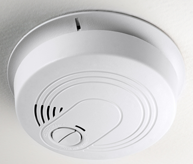As of January 1, 2014, all dwelling units intended for human occupancy for which a building permit is issued on or after January 1 for alterations exceeding $1,000, all single-family dwelling and factory-built housing which is sold, and all dwellings (multiple-dwelling complexes and single-family dwellings) units that are rented or leased, must have smoke alarms installed that meet the following conditions:
- Display the date of manufacture on the device;
- Provide a place on the device where a date of installation can be written;
- Incorporate a hush feature; and
- Incorporate an end-of-life feature that provides notice that the device needs to be replaced
SB 745 amended SB1394 to allow the last criteria for battery operated devices to contain a non-replaceable, non-removable battery that is capable of powering the smoke alarm for a minimum of 10 years to be extended to July 1, 2014.
California law (Cal. Health and Safety Code section 13113.7) requires smoke alarms to be installed in every “dwelling intended for human occupancy.” There is no exception for single-family properties. These smoke alarms must be approved and listed by the State Fire Marshal and installed in accordance with the State Fire Marshal’s regulations at the time of installation (Cal. Health & Safety Code sections 13113.7 and 13113.8). Current California State Building code requires that smoke alarms be located in:
- the hallway outside the bedrooms
- in each bedroom
- on every floor regardless of whether there is a bedroom on that floor
Furthermore, for any new construction or any additions, alterations, or repairs after August 14, 1992 that exceed $1,000 in cost and for which a permit is required, a smoke alarm must be installed in each bedroom in addition to being centrally located in the corridor or area outside the bedroom. Commencing January 1`, 2014, this law will require that for all dwelling units intended for human occupancy for which a building permit is issued for alterations, repairs or additions for more than $1,o00, the issuer of the building permit will not sign off on the completion o the work unless the owner demonstrates that all smoke alarms required for the dwelling unit are devices approved by the State Fire Marshall. For new conssrutction commencing August 14, 1992 only, the smoke alarm must be hardwired with a battery backup. For all other homes, the smoke alarm may be battery operated (Cal.Health & Safety Code 13113.7).
Commencing July 1, 2014
- The State Fire Marshal requires battery operated smoke alarms to contain non-replaceable, non-removable battery capable of powering the smoke alarm for at least 10 years. (there are some exceptions to this rule for smoke alarms in existing inventory, but only until July 1, 2015 (Cal Health & Safety Code 13114). These requirements will impact any newly installed battery operated smoke alarms (H&S Code 13113.7). In other words, unless, local laws state differently, any smoke alarm that was approved at the time of installation may remain but any newly installed smoke alrm will have to comply with the State Fire Marshall’s stricter requirements.
Commencing January 1, 2015
Newly installed battery operated smoke alarms will be required to:
- display the date of manufacture on the device
- provide a place on the device to insert the date of installation
- incorporate a hush feature (a “hush” feature will momentarily silence the alarm to allow whatever set off the alarm such as smoke from the kitchen, a chance to dissipate. A “hush” feature, however does not turn off the smoke alarm, and after a few minutes, the alarm will return if the smoky conditions persist.
Disclosure requirements for the sale of a single family home, two-unit dwelling, or factory-built home
Unless exempt, the transferor/seller must provide the buyer with a written statement indicating that the proper is in compliance with the law governing smoke alarms. Disclosure exemptions:
- Transfers that require a copy of a public depart to be given to the buyer
- Transfers pursuant to court order
- Transfers during foreclosure or trustee’s sale or through deed in lieu of foreclosure (REO transfers or subsequent transfers by a beneficiary after the foreclosure or trustee’s sale are not exempt, however)
- Transfers by a fiduciary of a trust, decedent’s estate, guardianship or conservatorship.
- Transfers between co-owners
- Transfers to a spouse or to a child, grandchild, parent, grandparent or other direct ancestor or descendent
- Transfers between spouses in connection with a dissolution of marriage or similar proceeding
- Transfers by the State Controller pursuant to the Unclaimed Property Law
- Transfers as a result of failure to pay property taxes
The specific requirements may vary depending on the type of property, the number of units and the number of stories of the property. In addition, municipalities may enact more stringent requirements. For example, some municipalities may require hard-wired smoke alarms. For that reason, it is imperative to check with the local department of building and safety to determine if there are any local requirements which may be more stringent than the state law.
This article contains information that is Copyright © 2103 California Association of REALTORS (C.A.R.) and the San Diego Association of REALTORS (S.D.A.R.).
CalBRE Broker License No. 00877135

